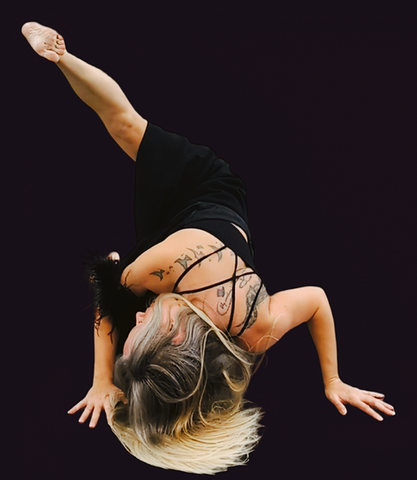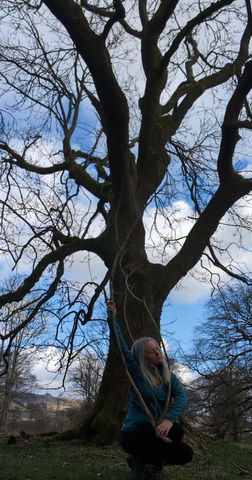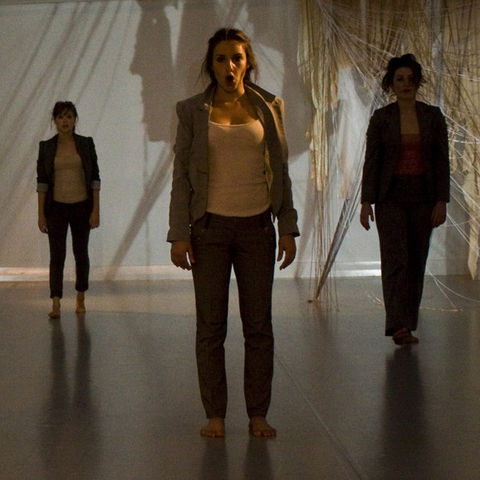
GEMMA COLLARD-STOKES
Dance Artist

THE ARTIST
Gemma Collard-Stokes
Gemma Collard-Stokes is an interdisciplinary performance artist, researcher and educator based in Derbyshire. A common aspect across Gemma's academic and artistic work is the exploration of dance in its therapeutic capacity. This extends from her doctorate research, ‘Dissolving Borders’ (2017), in which she demonstrated how principles of ecologically conscious movement improvisation can be applied to acts of writing in order to enrich articulation and assimilation of the suchness of a union between body, mind and Earth.
Gemma's current interests align with prominent subjects within women’s studies, such as motherhood, birth trauma, body image disturbances, aging and invisibility. These investigations centre on how dance, and in particular ecosomatic movement practice, can offer [re]connection for those who experience a growing sense of detachment from their body. This work is embedded in enquiry that seeks to explore the ways in which human relationships with our environment (including the natural world of animals and plants) through bodily interactions can support recovery, connection and orient us in the world.




Upcoming Events

 Poetry and Movement Workshop at Postlip Hall and grounds, CheltenhamSat 02 AprPostlip Hall
Poetry and Movement Workshop at Postlip Hall and grounds, CheltenhamSat 02 AprPostlip Hall
 Body as Place WorkshopFri 09 JulCivic Lab Symposium
Body as Place WorkshopFri 09 JulCivic Lab Symposium
 Writing Body Workshop at Poetry Emergency!Fri 22 NovSalford University New Adelphi Building
Writing Body Workshop at Poetry Emergency!Fri 22 NovSalford University New Adelphi Building
 Moving Words WorkshopWed 20 NovEast Midlands UK
Moving Words WorkshopWed 20 NovEast Midlands UK
 Environmental Movement PracticeFri 11 OctCraft Village Markeaton Park Derby
Environmental Movement PracticeFri 11 OctCraft Village Markeaton Park Derby

PUBLICATIONS

RECREATIONAL BURLESQUE AND THE AGING FEMALE BODY: CHALLENGING PERCEPTIONS
Gemma Collard-Stokes (2020) Recreational burlesque and the aging female body: challenging perceptions, Journal of Women & Aging, DOI: 10.1080/08952841.2020.1839319
Rejecting the association between aging and asexuality that persists in the UK’s cultural representation of the female aging body, this paper reveals the importance of sensuality and maintaining physical agency to older women. It pays attention to the phenomena of participating in recreational burlesque classes to counter and negotiate potentially negative representations. Through in-depth interviews and researcher-as-participant observation, the paper explores the transformative possibilities mediated through participating in theatrically glamorized performance classes and the processes thereby initiated. The author examines the potential of burlesque to offer improvements to wellbeing and healthier self-perceptions for aging women experiencing marginalization through social invisibility.

CREATIVE CRITICAL REPRESENTATION OF THE CHOREOGRAPHER’S CREATION PROCESS
Gemma Collard-Stokes (2020) Creative Critical Representation of the Choreographer’s Creation Process, Dance Chronicle, 43:3, 343-349
This review examines Jonathan Burrows: Towards a Minor Dance, a monography by Daniela Perazzo Domm published within the Palgrave Macmillan’s New World Choreographies series. Perazzo Domm’s first monograph introduces British choreographer Jonathan Burrows, whose work is considered an important contribution to contemporary performance practices’ effort to rethink what constitutes choreography. The review focuses of the books main themes of socio-political creativity and collaboration at the intersection(s) of artist, body and composition. The review observes this through the endeavour to question relational aspects between the writer and the choreographer’s creative process.

‘WITHNESS’: CREATIVE SPECTATING FOR RESIDENTS LIVING WITH ADVANCED DEMENTIA IN CARE HOMES
Astell-Burt C, McNally T. Collard-Stokes G, Irons Y. (2020) 'Withness': Creative spectating for residents living with advanced dementia in care-homes. Journal of Applied Arts and Health, 11 (1/2): 125-133.
Aiming to illustrate the potential for puppetry as a useful resource in dementia care, the authors argue unusually that play with puppets derives not particularly from drama or theatre, but fundamentally from the performative relationship people have with objects. The puppeteers of the study achieved remarkable emotional connection with care-home residents through an experience of puppetry, which dissolved the unitary autonomy of the puppet, recontextualising it relationally as the puppeteer-with-puppet-with-spectator. It is this ‘withness’ that ignited the creative spark of presence of the residents. For a moment of trust and child-like joy kinaesthetic memories stirred in them, appearing to break down emotional barriers between the person and the world around them and indicating comparatively longer-term therapeutic benefits.

EXPRESSING SUCHNESS: ON THE INTEGRATION OF WRITING INTO A DANCE PRACTICE
Collard-Stokes, G. (2019). 'Expressing suchness: on the integration of writing into a dance practice'. Journal of Dance & Somatic Practices, 11(1), pp. 115-128. DOI
10.1386/jdsp.11.1.115_1.
This article details the unique pairing of dance and writing, the likes of which are often considered two very different beasts. It examines how approaches to movement improvisation have been used to form and inform innovative methods of entering into the act of writing from the experience of dance. The argument authenticates the current renewed appreciation for the possibilities of writing to enable further creative critical engagement. Consequently, the meeting of creativity and criticality is one in which the dancer playfully explores and examines the suchness of one’s dancing. Suchness is therefore understood as the unique sum of qualities experienced by the dancer – the point at which clarity and closeness facilitate connection through the images, feelings and sensations evoked by dance. In summary, the article outlines the relationship between dance and writing, before exploring the methods used to facilitate a dancer’s assimilation and validation of what happens for them when they dance.

FINDING COMMON GROUND THROUGH LANGUAGE AND MOVEMENT: EXAMINING THE ROLE OF THE WRITER IN ROSEMARY LEE’S THE SUCHNESS OF HENI AND EDDIE.
Collard-Stokes, G. (2012) 'Finding common ground through language and movement: examining the role of the writer in Rosemary Lee’s The Suchness of Heni and Eddie', Research in Dance Education, 13 (2):215.
DOI
10.1080/14647893.2012.687370
Since the development of interdisciplinary practice, dance has fashioned and cultivated many relationships with other art forms. In this search to uncover new territory choreographers often merge art forms to facilitate the broadening of their field. Writing has always been a successful tool in the communication and critique of dance performance. However, writing has also played a considerable role in the process of creating dance, yet this association remains under-represented. This writing aims to demonstrate some of the ongoing and recent perspectives that dance and writing have nurtured, paying particular attention to the act of creative writing and dance in a collaborative partnership. This investigation concerns itself with the act of writing as creative discourse, presenting the argument for the writer to be considered an invaluable partner in the creative process. Through practical research, a case study was carried out examining the ongoing collaboration between choreographer Rosemary Lee and writer Niki Pollard. The findings from this research provide evidence of how modes of writing can contribute to choreographic investigation, providing a performative research bridge between practical and theoretical negotiations.

ARTIST-LED, ARTIST-USED: EXPERIENCES AT COVENTRY'S SUMMER DANCING 2009
Pollard, N., Coe, K., Collard-Stokes, G., Le Quesne, L., and Moran, J. (2009) 'Artist-led, artist-used: experiences at Coventry's Summer Dancing 2009', Journal of Dance and Somatic Practices, 1 (2):199.
DOI
10.1386/jdsp.1.2.199_1
This multi-authored article arises from an artist-led festival of dance and probes what is entailed by the commitment to an artist-led structure. The festival, Summer Dancing 2009 in Coventry, is becoming significant in the United Kingdom as a gathering, both regionally and nationally, of practitioners whose expertise is grounded in what might be termed somatic dance practices. It is proposed that artist-led may indicate an aim to be led by artists for other artists; that is, for an event or organization to be artist-used and useful. With the question of artists' use at the fore, the article reports on a festival panel debate and on a project of practitioner-focused writing, examining how a dance practitioner may be stimulated, challenged or find connections to an existing practice.





























